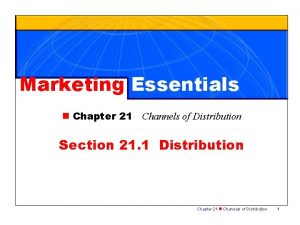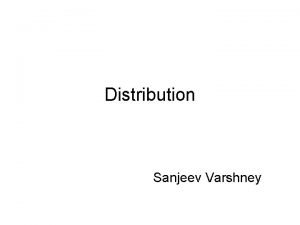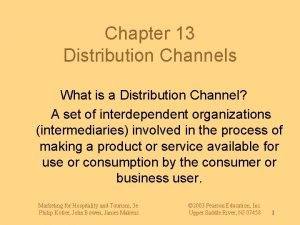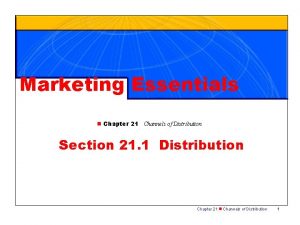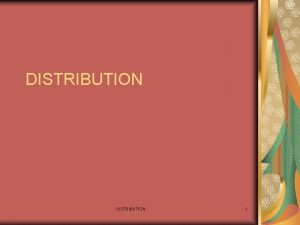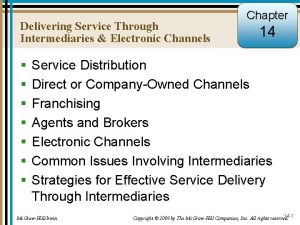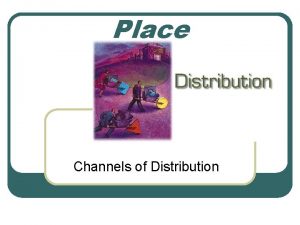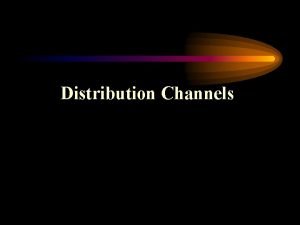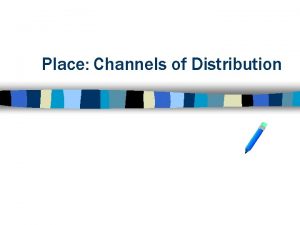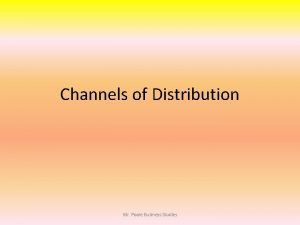Channels of Distribution Channel of Distribution The path

Channels of Distribution

Channel of Distribution The path or routes, that goods and services take from the producer to the ultimate consumer or industrial user.

Producer (Manufacturer) • Makes or provides goods and services.

Ultimate Consumer • Is anyone who personally uses a good or service to satisfy her/his own wants or needs.

Industrial User • Is a business that buys materials, services, or goods that will be used to make other goods or used in the operation of the company.

Direct and Indirect Channels • Direct distribution occurs when the goods or services are sold from the producer directly to the customer – no intermediaries are involved. – Example: A farmer sells corn at a street market. • Indirect distribution involves one or more intermediaries.

Distribution Intensity • E-Commerce – products are sold to customers and industrial users through the use of the Internet. • B 2 B operations provide one-stop shopping and substantial savings for industrial buyers.

Channel Members are called intermediaries • Operate between producer and consumer or user to help in the movement of goods and services.

Types of Intermediaries-Retailers: Businesses that buy consumer goods and sell them to the ultimate consumers.

Types of Intermediaries -Wholesalers • Wholesalers: Businesses that buy goods from producers or agents and sell them to retailers. – Wholesalers buy a variety of goods from many producers and sell groups of related products to retailers.

Types of Intermediaries-Agents • Agents: Businesses or individuals that assist in the sale and/or promotion of goods and services but do not buy them from the producer.

Importance of intermediaries • Through the use of intermediaries, producers are able to match their production to the wants and needs of consumers or industrial users. • Intermediaries will have products and services at the right place, at the right times and at the least costs.

Channels in the consumer markets

Channels in industrial markets

Understanding Distribution Planning Key Considerations in Distribution Planning • Involves decisions about a product’s physical movement (product perishability, technical or fashionable nature, etc. ) • transfer of ownership from producer to consumer • The decisions affect a firm’s marketing program.

Understanding Distribution Planning • Multiple Distribution – used when a product fits the needs of both industrial and customer markets. “We're #1 in every foodservice segment: K-12 Schools, College/University, Healthcare, Business Dining, Lodging, and Restaurants!“ You can also buy this brand in your local grocery store.

Understanding Distribution Planning • Control vs. Costs – Producers must weigh the control they want to keep – Who does the selling? • A direct sales force is costly. • With an agent, a manufacturer loses some of its control over how sales are made

Understanding Distribution Planning – Who dictates the terms? Giant retailers (Wal. Mart, Home Depot) require special services like shipping, pricing, packaging, and merchandising.

Distribution Intensity • Exclusive Distribution – involves protected territories in a given geographic area. • Prestige, image, channel control, and a high profit margin for both the manufacturer and intermediaries. Click the receiver to see the number of dealers in your area.

Distribution Intensity • Selective Distribution – means that a limited number of outlets in a given geographic area are used to sell the product. • The intermediaries chosen are selected for their ability to cater to the final users that the manufacturer wants to attract.

Distribution Intensity • Intensive Distribution – involves the use of all suitable outlets to sell a product. • The goal is complete market coverage
- Slides: 21


